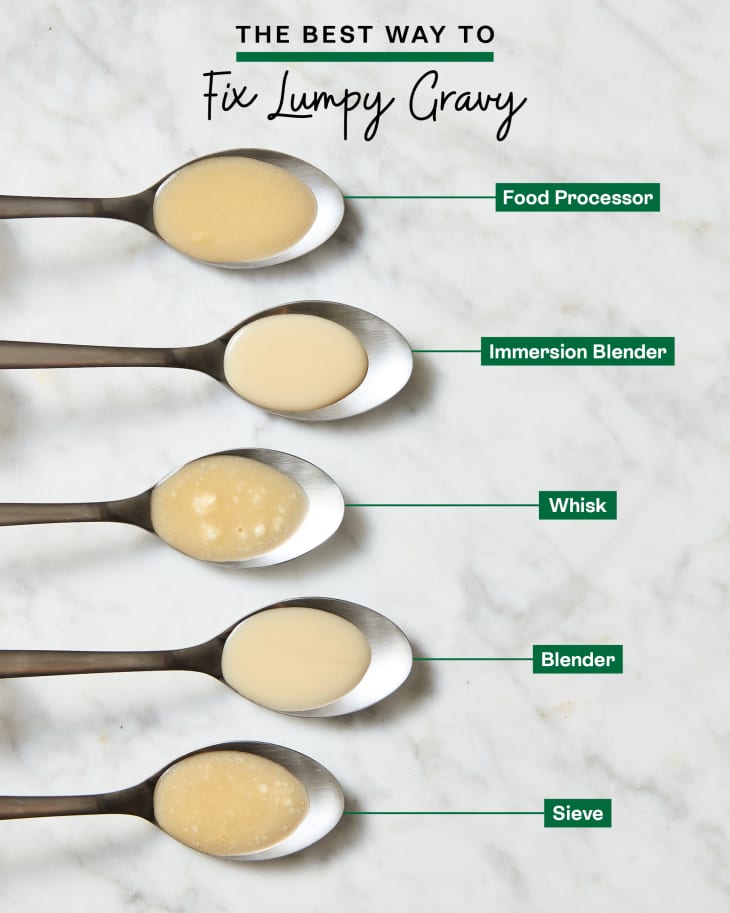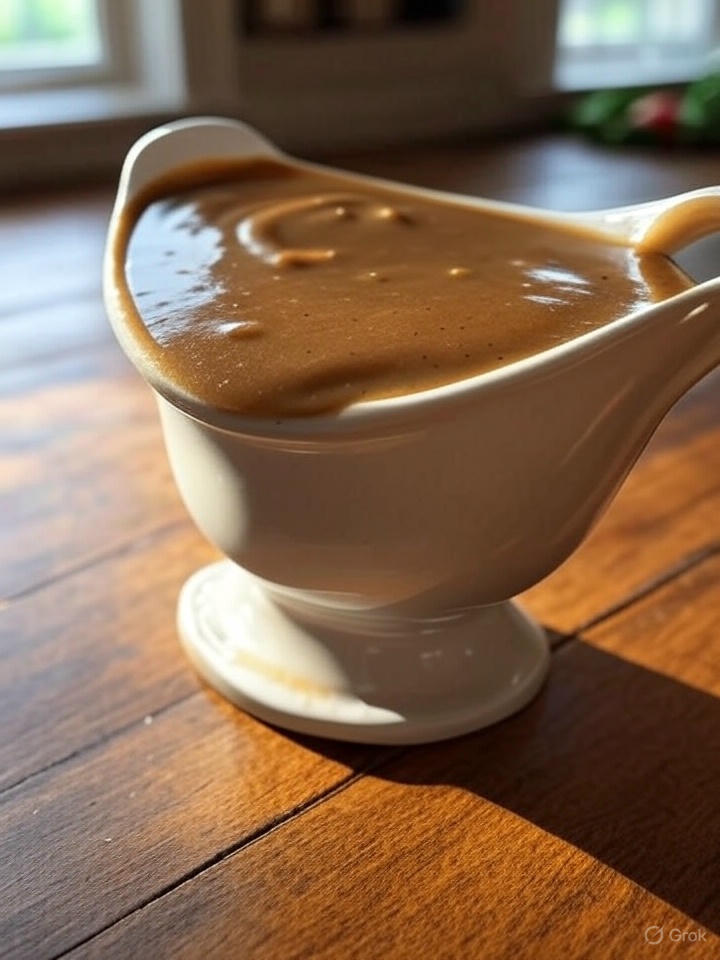Table of Contents
You’ve spent hours preparing a delicious meal, and now it’s time to finish it off with the perfect gravy. But as you pour it over your dish, you notice unsightly lumps ruining its smooth texture.
Sound familiar? You’re not alone. Many home cooks face this frustrating issue. But don’t worry—there’s a solution waiting for you. Imagine serving a meal where every element is flawless, including a velvety, lump-free gravy that complements each bite. You’ll discover simple, effective strategies to banish those pesky lumps forever.
Get ready to impress your guests and elevate your cooking game. Stick with us, and you’ll never have to deal with lumpy gravy again.
Also Read: Why You Should Be Using Beef Tallow?
Common Causes Of Lumpy Gravy
Gravy is a staple in many kitchens, adding flavor and richness to meals. But why does homemade gravy sometimes have lumps? Understanding the common causes of lumpy gravy is essential for smooth, delicious results. From improper flour mixing to boiling too rapidly, various factors can lead to those pesky lumps. Let’s explore these causes and learn how to ensure a perfect, lump-free sauce every time.
Improper Flour Mixing
The way you mix flour can significantly impact gravy consistency. Flour clumps in gravy are a common problem, often due to improper mixing techniques. For a smooth sauce, it’s essential to blend the flour with fat before adding liquid. This process, known as making a roux, helps distribute the flour evenly.
Consider these tips to avoid lumps:
- Measure accurately: Use the right ratio of flour to fat.
- Mix thoroughly: Stir the flour and fat until smooth.
- Add liquid gradually: Slowly pour in broth or milk while whisking.
Avoid adding flour directly to hot liquid, as it may clump immediately. Instead, create a slurry by mixing flour with a bit of cold water or broth, then add it slowly to the hot gravy. This method ensures even distribution and prevents lumps.
| Technique | Result |
|---|---|
| Roux | Smooth, lump-free gravy |
| Direct Flour Addition | Lumpy gravy |
Too Rapid Boiling
Boiling gravy too quickly can lead to lumps. Rapid boiling causes the liquid to evaporate fast, leading to uneven cooking and thickening. This issue is common in gravy consistency troubleshooting.
To prevent boiling gravy issues, follow these simple steps:
- Heat gradually: Start with medium heat and increase slowly.
- Stir constantly: Keep the gravy moving to avoid sticking and burning.
- Watch the pot: Keep an eye on the consistency and adjust heat as needed.
Avoid boiling the gravy until it’s thick. Instead, aim for a gentle simmer. This approach ensures even cooking and reduces the risk of lumps. Smooth gravy tips include maintaining a steady temperature and constant stirring for perfect results.
Insufficient Straining
Straining gravy properly is a crucial step in achieving a smooth texture. Insufficient straining can leave behind flour clumps in gravy, affecting the final product. After cooking, passing the gravy through a fine-mesh sieve can remove any remaining lumps and create a velvety finish.
Consider these steps for effective straining:
- Use a fine-mesh sieve: Select a sieve that can catch even small particles.
- Press gently: Use a spoon to press the gravy through the sieve.
- Check consistency: Ensure the gravy is smooth before serving.
For those who experience homemade gravy problems, straining is a simple yet effective solution. This technique ensures that any remaining lumps are removed, leaving you with a deliciously smooth sauce. Remember, cooking techniques for gravy are as much about the process as the ingredients.

Credit: www.realsimple.com
Preventing Lumps In Gravy
Gravy is a staple in many delicious meals, yet nothing can ruin its smooth allure like unexpected lumps. Discovering why gravy has lumps isn’t just about understanding the problem; it’s about finding solutions. Preventing lumps in gravy requires attention to detail and technique. Here, you will learn how to achieve a lump-free sauce through proper methods and tips.
Use A Roux
Creating a roux is a classic technique to prevent gravy lumps. It’s a simple combination of fat and flour that acts as a thickening agent. Roux preparation begins with melting butter or heating oil in a pan. Add an equal amount of flour and stir consistently. This mixture should cook until it reaches a golden color.
- Fat Options: Butter, oil, or drippings.
- Flour Types: All-purpose flour is commonly used.
Using a roux stabilizes the sauce and ensures the flour is evenly distributed. The heat helps break down the flour’s starches, making it less likely to clump. For best results, cook the roux for a few minutes, allowing the flour to cook thoroughly. This method is a cornerstone in achieving smooth gravy consistency.
Whisking Techniques
Effective whisking methods are crucial to achieving smooth gravy. The whisking technique breaks down potential lumps before they form. Use a sturdy whisk and employ consistent circular motions. This helps integrate all ingredients smoothly, reducing the risk of lumps.
- Choose the Right Whisk: Balloon whisks are ideal for this task.
- Whisk Aggressively: Rapid motions ensure even mixing.
- Maintain Constant Motion: Continuous whisking prevents flour from settling.
Whisking techniques are especially vital when thickening agents like cornstarch or flour are added. The key is consistency and speed. These culinary tips can transform your gravy-making process, ensuring a lump-free sauce every time.
Gradual Liquid Addition
Liquid incorporation is another method to prevent lumps in gravy. Adding liquid gradually allows for better blending and reduces the risk of clumps. Start by slowly pouring a small amount of liquid into the roux or base while whisking. This keeps the mixture smooth.
| Liquid Type | Recommended Amount |
|---|---|
| Broth | Start with 1 cup |
| Milk | Start with 1 cup |
Gradual liquid addition ensures complete integration. If the liquid is added too quickly, lumps can form due to uneven mixing. Slow pouring, coupled with constant whisking, achieves desirable gravy consistency. This technique is a trusted method among cooking techniques for smooth gravy production.
Fixing Lumpy Gravy
Gravy is a staple in many cuisines, adding flavor and richness to meals. But nothing can ruin a meal faster than lumpy gravy. These lumps can be caused by improper mixing, uneven heat, or using the wrong flour. Fortunately, there are effective ways to fix lumpy gravy and achieve that smooth texture everyone loves. Let’s explore some methods to ensure your gravy is lump-free and delicious.
Blending Methods
One effective way to tackle lumps in gravy is by blending. A blender can quickly smooth out those pesky clumps. Here’s how to do it:
- Immersion Blender: This tool is ideal for quick fixes. Simply place the immersion blender in the pot and blend until smooth.
- Standard Blender: Pour the lumpy gravy into a standard blender. Blend on low speed until the lumps disappear.
Pros and Cons of Blending:
| Pros | Cons |
|---|---|
| Quick and efficient | May require extra cleaning |
| Can be used for other kitchen tasks | Need to transfer hot liquid |
Blending is a reliable method but ensure safety when dealing with hot liquids. Always secure the blender lid to avoid spills.
Using A Strainer
Another effective method is straining. This involves passing the gravy through a fine mesh strainer. This technique catches lumps and leaves you with smooth gravy.
Steps to Use a Strainer:
- Place a strainer over a clean pot or bowl.
- Pour the gravy through the strainer.
- Use a spoon to press the liquid through, leaving lumps behind.
Benefits of Using a Strainer:
- Simple and requires minimal equipment.
- Removes even small lumps.
This method is straightforward and requires only a strainer. It’s perfect for those who prefer not to use electrical appliances.
Incorporating Additional Liquid
Adding more liquid can help dissolve lumps and thin out the gravy. This method works well if the gravy is too thick.
How to Incorporate Liquid:
- Add a small amount of broth or water.
- Whisk vigorously to break down lumps.
- Continue adding liquid until desired consistency is reached.
Advantages of Adding Liquid:
| Advantages | Considerations |
|---|---|
| Easy to adjust consistency | May dilute flavor |
| No special tools needed | Requires careful whisking |
Adding liquid is a simple fix. Just remember to taste and adjust the seasoning afterward to maintain the flavor.
:max_bytes(150000):strip_icc()/How-to-Fix-Lumpy-Gravy-FT-BLOG1124-6c0b5fc2b1804599aba1cb2a67431a1c.jpg)
Credit: www.foodandwine.com
Choosing The Right Ingredients
Making gravy is an art that requires the right blend of ingredients. Gravy lumps can ruin your dish’s texture and taste. The secret to a smooth, lump-free gravy lies in choosing the right ingredients. From the thickening agents to the quality of broth and the freshness of other components, each element plays a crucial role. This guide offers culinary tips and troubleshooting techniques to ensure your sauce preparation is perfect every time.
Types Of Thickening Agents
Thickening agents are essential for achieving the desired gravy consistency. Selecting the proper agent can prevent gravy lumps and improve the texture.
- Flour: A common choice, flour creates a smooth texture. Mix it with a bit of fat to form a roux before adding liquid.
- Cornstarch: This creates a glossy finish. Mix it with cold water to form a slurry before incorporating it into the broth.
- Arrowroot: Suitable for those seeking a gluten-free option. It thickens quickly and provides a clear, smooth sauce.
Using the right technique with these agents is crucial. For example, cornstarch requires careful blending to avoid lumps. Arrowroot offers a fast and easy solution but should be added at the end of cooking to maintain its properties.
Quality Of Broth
Broth quality significantly impacts the final taste and texture of your gravy. High-quality broth enhances flavor while providing a base for consistency.
| Broth Type | Benefits |
|---|---|
| Homemade Broth | Rich in flavor, customizable, less sodium. |
| Store-bought Broth | Convenient, consistent flavor, readily available. |
Using homemade broth allows control over the taste and nutritional content, while store-bought options offer convenience. Pay attention to sodium levels in commercial broths to avoid overpowering your dish. Always taste the broth before adding it to ensure it complements your cooking techniques and enhances the gravy consistency.
Using Fresh Ingredients
Fresh ingredients are vital for a flavorful, lump-free gravy. They ensure the natural taste and aroma are preserved in the sauce preparation.
- Fresh Herbs: They infuse the gravy with aromatic flavors. Add them during cooking for a richer taste.
- Vegetables: Fresh onions, garlic, and carrots boost flavor. Sauté them before adding to the broth.
- Meat Drippings: Use fresh drippings from roasted meat to add depth and richness.
Incorporating fresh ingredients enhances the dish’s overall quality. Regularly check for freshness to avoid any off tastes. A lump-free gravy starts with fresh ingredients, ensuring each bite is delightful and the flavors are well-balanced.
Expert Tips For Smooth Gravy
Gravy adds a rich flavor to any meal, but lumps can ruin the experience. If you’re wondering, “Why does my gravy have lumps?” you’re not alone. Many face this common issue. Fortunately, with a few expert tips, you can achieve smooth, lump-free gravy every time. Let’s explore some practical solutions for perfect gravy.
Temperature Control
Temperature plays a crucial role in achieving smooth gravy. Maintaining the right temperature for gravy can prevent lumps and ensure a velvety texture.
- Start Cold: Mix your thickening agent, like flour or cornstarch, with cold water or broth before adding it to hot liquids. This prevents clumps from forming.
- Gradual Heating: Slowly increase the heat when combining the thickening mixture with the hot broth. This helps in avoiding common gravy mistakes like sudden clumping.
- Consistent Stirring: Stir continuously while the gravy heats. This ensures even heat distribution and prevents lumps from forming.
| Temperature for Gravy | Action |
|---|---|
| Cold | Mix thickening agents |
| Warm | Combine with broth |
| Hot | Simmer and stir |
Following these steps can help you avoid gravy lumps and enjoy a smooth, delightful sauce.
Resting Time
Allowing your gravy to rest is an often overlooked but vital step. Resting time for gravy can significantly impact its texture and flavor.
- Let It Settle: After cooking, let the gravy sit for a few minutes. This helps in reducing excess steam and allows flavors to meld.
- Check Consistency: Resting helps thicken the gravy naturally. If it becomes too thick, add a splash of broth or water and stir gently.
- Reheat Gently: Before serving, reheat the gravy slowly, stirring occasionally to maintain a smooth texture.
These gravy preparation tips help in achieving a balanced and flavorful sauce, free from unwanted clumps.
Serving Techniques
How you serve your gravy can also affect its texture. Proper serving techniques ensure a smooth pour and even distribution.
- Use a Fine Strainer: If lumpy, strain the gravy through a fine sieve to remove solid bits. This is a quick way to fix lumpy gravy.
- Choose the Right Vessel: Use a gravy boat with a spout for a controlled pour. This prevents splashes and uneven distribution.
- Stir Before Serving: Always stir the gravy before serving. This ensures all ingredients are well combined and prevents settling.
Implementing these smooth gravy techniques ensures your gravy enhances the meal without any serving lumpy gravy mishaps.

Credit: www.thekitchn.com
Frequently Asked Questions
How Do You Dissolve Lumps In Gravy?
To dissolve lumps in gravy, whisk vigorously while adding small amounts of liquid. Use a blender for stubborn lumps. Strain the gravy through a fine-mesh sieve for a smoother texture. Stir continuously to prevent new lumps from forming. Maintain a consistent heat to keep the mixture smooth.
How Do You Fix Lumpy Sauce?
Heat sauce gently and stir continuously. Use a whisk to break up lumps. Add a splash of liquid if needed. Blend with an immersion blender for smooth texture. Strain through a fine sieve for extra refinement.
How To Fix Lumpy Gravy Without Flour?
Use a fine mesh strainer to remove lumps from gravy. Blend the strained gravy until smooth. Add a starch like cornstarch or potato starch for thickening. Reheat while whisking vigorously to achieve desired consistency. Ensure consistent stirring to prevent future lumps.
How To Fix Curdled Gravy?
Fix curdled gravy by whisking vigorously to smooth out lumps. Add warm liquid gradually to restore consistency. Use a blender if needed for a silkier texture. Adjust seasoning if necessary. Avoid boiling to prevent further curdling. Always serve warm for best texture and flavor.

Conclusion
Smooth gravy is within your reach. First, whisk ingredients thoroughly. This prevents lumps from forming. Second, strain gravy if lumps persist. A fine-mesh sieve works best. Third, maintain consistent heat while cooking. This ensures even thickening. Finally, practice makes perfect.
Over time, you’ll create lump-free gravy. Remember, patience is key. Simple techniques lead to delicious results. So, embrace these tips. Your gravy will be smooth and tasty. Invite friends and family to enjoy it. They’ll appreciate your effort. Celebrate your cooking success.
Gravy should enhance your meal, not frustrate you. Enjoy your culinary journey.


